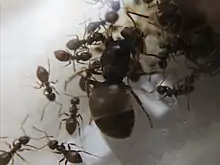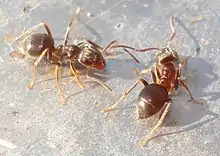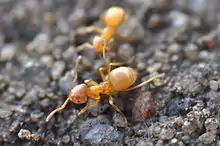Lasius
Lasius is a genus of formicine ants.[2] The type species for this genus is the black garden ant, Lasius niger. Other major members, which live in drier heathland, are the cornfield ant, L. neoniger, and L. alienus. Other species include the temporary social parasites of the L. mixtus group and the hyper-social parasite Lasius fuliginosus. Lasius flavus is also a commonly seen species, building grassy hillocks in undisturbed pasture. In the Alps, these mounds - always aligned east to catch the first rays of the rising sun - have been traditionally used by goatherds as natural compasses.
| Lasius | |
|---|---|
 | |
| Lasius niger, type species. | |
| Scientific classification | |
| Kingdom: | Animalia |
| Phylum: | Arthropoda |
| Class: | Insecta |
| Order: | Hymenoptera |
| Family: | Formicidae |
| Subfamily: | Formicinae |
| Tribe: | Lasiini |
| Genus: | Lasius Fabricius, 1804 |
| Diversity[1] | |
| 133 species | |
| Synonyms | |
| |
Moisture ants
Many Lasius species, known collectively as "moisture ants" in the United States, make their nests in and around moist rotting wood as well as under rocks.[3][4] They can infest buildings, particularly foundation forms in contact with soil, becoming a minor nuisance.[5][3] They are not considered a structural threat because they only make their galleries in wood that is already decayed.[5] Some species build "cartonlike" nests in moist locations made of decayed wood fragments cemented together with honeydew and the ant's mandibular gland secretions.[4] Workers are monomorphic, 2 to 3 mm long, yellow to dark brown.[3] They are secretive, and forage mostly at night for honeydew and other sweet substances, and may also prey on small insects.[3] Winged reproductive males and females swarm in late summer and fall, which is when building infestations may be noticed.[3] They are distinguished from carpenter ants (Camponotus), another structure-infesting species, by being much smaller, and having a notch in the dorsal thorax (top of the center body division), where carpenter ants have a rounded thorax.[5][3] Widespread moisture ant species include L. alienus and L. neoniger, as well as some Acanthomyops species.[4]
Species



- Lasius affinis (Schenck, 1852)
- Lasius alienoflavus Bingham, 1903
- Lasius alienus (Foerster, 1850)
- Lasius americanus Emery 1893
- †Lasius anthracinus (Heer, 1867)
- Lasius aphidicola (Walsh, 1863)
- Lasius arizonicus Wheeler, 1917
- Lasius atopus Cole, 1958
- Lasius austriacus Schlick-Steiner, Steiner, Schödl & Seifert, 2003
- Lasius balcanicus [no authors], 1988
- Lasius balearicus Talavera, Espadaler & Vila, 2014
- Lasius bicornis (Foerster, 1850)
- Lasius brevicornis Emery 1893
- Lasius breviscapus Seifert, 1992
- Lasius brunneus (Latreille, 1798)
- Lasius buccatus Stärcke, 1942
- Lasius bureni (Wing, 1968)
- Lasius californicus Wheeler, 1917
- Lasius capitatus (Kuznetsov-Ugamsky, 1927)
- Lasius carniolicus Mayr, 1861
- †Lasius chambonensis Piton & Théobald, 1935
- Lasius cinereus Seifert, 1992
- Lasius citrinus Emery, 1922
- Lasius claviger (Roger, 1862)
- Lasius colei (Wing, 1968)
- Lasius coloradensis Wheeler, 1917
- Lasius coloratus Santschi, 1937
- Lasius creightoni (Wing, 1968)
- Lasius crinitus (Smith, 1858)
- Lasius crispus Wilson, 1955
- Lasius crypticus Wilson, 1955
- Lasius distinguendus (Emery, 1916)
- Lasius draco Collingwood, 1982
- Lasius elevatus Bharti & Gul, 2013
- Lasius emarginatus (Olivier, 1792)
- †Lasius epicentrus Théobald, 1937
- Lasius escamole Reza, 1925
- Lasius exulans Fabricius, 1804
- Lasius fallax Wilson, 1955
- Lasius flavescens Forel, 1904
- Lasius flavoniger Seifert, 1992
- Lasius flavus (Fabricius, 1782)
- Lasius fuji Radchenko, 2005
- Lasius fuliginosus (Latreille, 1798)
- Lasius gebaueri Seifert, 1992
- †Lasius globularis (Heer, 1849)
- Lasius grandis Forel, 1909
- Lasius hayashi Yamauchi & Hayashida, 1970
- Lasius hikosanus Yamauchi, 1979
- Lasius himalayanus Bingham, 1903
- Lasius hirsutus Seifert, 1992
- Lasius humilis Wheeler, 1917
- Lasius illyricus Zimmermann, 1935
- †Lasius inflatus (Zhang, 1989)
- Lasius interjectus Mayr, 1866
- Lasius japonicus Santschi, 1941
- Lasius jensi Seifert, 1982
- Lasius karpinisi Seifert, 1992
- Lasius koreanus Seifert, 1992
- Lasius lasioides (Emery, 1869)
- Lasius latipes (Walsh, 1863)
- Lasius lawarai Seifert, 1992
- †Lasius longaevus (Heer, 1849)
- Lasius longiceps [no authors], 1988
- Lasius longicirrus Chang & He, 2002
- †Lasius longipennis (Heer, 1849)
- Lasius magnus Seifert, 1992
- Lasius mellea (Provancher, 1881)
- Lasius meridionalis (Bondroit, 1920)
- Lasius mexicanus Wheeler, 1914
- Lasius mikir Collingwood, 1982
- Lasius minutus Emery, 1893
- Lasius mixtus (Nylander, 1846)
- Lasius monticola (Buckley, 1866)
- †Lasius mordicus Zhang, 1989
- Lasius morisitai Yamauchi, 1979
- Lasius murphyi Forel, 1901
- Lasius myops Forel, 1894
- Lasius myrmidon Mei, 1998
- Lasius nearcticus Wheeler, 1906
- Lasius neglectus Van Loon, Boomsma & Andrasfalvy, 1990
- †Lasius nemorivagus Wheeler, 1915
- Lasius neoniger Emery, 1893
- Lasius nevadensis Cole, 1956
- Lasius niger (Linnaeus, 1758)
- Lasius nigrescens Stitz, 1930
- Lasius nipponensis Forel, 1912
- Lasius nitidigaster Seifert, 1996
- †Lasius oblongus Assmann, 1870
- Lasius obscuratus Stitz, 1930
- †Lasius obscurus (Heer, 1849)
- Lasius occidentalis Wheeler, 1909
- †Lasius occultatus (Heer, 1849)
- †Lasius ophthalmicus (Heer, 1849)
- Lasius orientalis Karavaiev, 1912
- Lasius pallitarsis (Provancher, 1881)
- Lasius paralienus Seifert, 1992
- †Lasius peritulus (Cockerell, 1927)
- Lasius piliferus Seifert, 1992
- Lasius platythorax Seifert, 1991
- Lasius plumopilosus Buren, 1941
- Lasius pogonogynus Buren, 1950
- Lasius productus Wilson, 1955
- Lasius przewalskii Ruzsky, 1915
- Lasius psammophilus Seifert, 1992
- Lasius pubescens Buren, 1942
- †Lasius pumilus Mayr, 1868
- †Lasius punctulatus Mayr, 1868
- Lasius rabaudi (Bondroit, 1917)
- Lasius reginae Faber, 1967
- Lasius rubiginosa (Latreille, 1802)
- Lasius ruficornis (Fabricius, 1804)
- Lasius sabularum (Bondroit, 1918)
- Lasius sakagamii Yamauchi & Hayashida, 1970
- Lasius schaeferi Seifert, 1992
- †Lasius schiefferdeckeri Mayr, 1868
- Lasius schulzi Seifert, 1992
- Lasius sitiens Wilson, 1955
- Lasius sonobei Yamauchi, 1979
- Lasius spathepus Wheeler, 1910
- Lasius speculiventris Emery, 1893
- Lasius subglaber Emery, 1893
- Lasius subumbratus Viereck, 1903
- Lasius talpa Wilson, 1955
- Lasius tebessae Seifert, 1992
- †Lasius tertiarius Zalessky, 1949
- †Lasius truncatus Zhang, 1989
- Lasius turcicus Santschi, 1921
- Lasius umbratus (Nylander, 1846)
- Lasius uzbeki Seifert, 1992
- †Lasius validus Zhang, 1989
- Lasius vestitus Wheeler, 1910
- †Lasius vetulus Dlussky, 1981
- Lasius viehmeyeri Emery, 1922
- Lasius wittmeri Seifert, 1992
- Lasius xerophilus MacKay & MacKay, 1994
References
- Bolton, B. (2014). "Lasius". AntCat. Retrieved 17 July 2014.
- "Genus: Lasius". AntWeb. Retrieved 2012-02-05.
- Klotz, John H. (2010). Urban Pest Management of Ants in California. UCANR Publications, Division of Agriculture and Natural Resources, University of California. pp. 54–55. ISBN 978-1601076649.
- Klotz, John H. (2008). Urban Ants of North America and Europe: Identification, Biology, and Management. Cornell University Press. pp. 39–44. ISBN 978-0801474736.
- Antonelli, Art (2007). "Extension Bulletin 1382: Moisture Ants" (PDF). WSU Extension. Washington State University. Archived from the original (PDF) on August 13, 2012. Retrieved March 4, 2013.
External links
 Media related to Lasius at Wikimedia Commons
Media related to Lasius at Wikimedia Commons